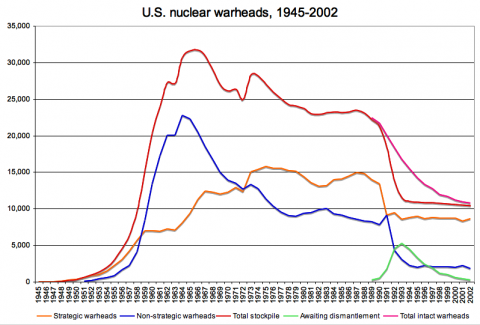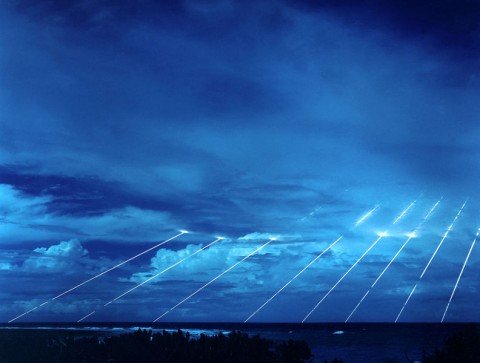Five to
[Image removed at the request of the copyright holder.]
The minute hand of the famous Doomsday Clock of the Bulletin of the Atomic Scientists has just moved closer to apocalypse: it is now set at five minutes to midnight. This is the most dangerous level it has been since 1988. The dangers currenty facing humanity are summarised thus:
The world stands at the brink of a second nuclear age. The United States and Russia remain ready to stage a nuclear attack within minutes, North Korea conducts a nuclear test, and many in the international community worry that Iran plans to acquire the Bomb. Climate change also presents a dire challenge to humanity. Damage to ecosystems is already taking place; flooding, destructive storms, increased drought, and polar ice melt are causing loss of life and property.
Obviously, the precise position is fairly arbitrary -- the relative movement back and forth is more significant, i.e. whether the world is getting more dangerous or not -- but it's interesting to reflect on the past movements of the minute hand:

So there are roughly four periods. The 1950s and most of the 1980s were periods of great danger; the 1960s/1970s and the 1990s periods of relative safety. We're now entering a fifth period, a dangerous one, according to the Bulletin.
Mostly this makes sense. The US lost its nuclear weapon monopoly in 1949 (and its thermonuclear one in 1955), and so in the 1950s, the possibility of a nuclear war had to be confronted. Fall-out shelters, duck-and-cover and Them! all pointed to a burgeoning fear of nuclear war. The 1980s was the era of Reagan and the oldest Soviet leader who was still alive on any given day. SS-18s, MX Peacekeepers, Cruise, Threads, The Day After. 'A strange game. The only winning move is not to play'. On the more hopeful side, there was détente in the 1970s -- SALT I, SALT II, the ABM treaty, the Helsinki Accords. The 1990s was the first post-Cold War decade, when a peace dividend seemed plausible. Significant cuts were made to the stockpiles of American and Russian nuclear weapons.
But what about the 1960s? Judging by the Clock, this was the sanest period before the early 1990s. Can that be right? The decade of Tsar Bomba, the Cuban Missile Crisis, the Berlin Wall, General Jack D. Ripper and that episode of The Twilight Zone where all the suburbanites are fighting over the only fallout shelter in the neighbourhood? It's true that there were signs of hope. The hotline between Washington and Moscow suggested that dialogue was possible between the two superpowers. And the Partial Test Ban Treaty in 1963 was the first step back from the brink; the Nuclear Non-Proliferation Treaty in 1968 was another. But actually, a serious two-way nuclear war only became possible during this time. During the 1950s, when the Doomsday Clock was set at two or three minutes to midnight, the USSR had derisory numbers of strategic nuclear warheads, only a couple of hundred or so (and given the illusory nature of the missile gap, would have had to brave US air defences to deliver them), whereas the US had already accumulated thousands, as the orange line in the following figures show:

So, in the 1960s, Soviet stockpiles of strategic nuclear weapons increased dramatically (over a thousand by 1966, twice that by 1969), and for the first time a strategic nuclear exchange worthy of the name was possible. So while, as I said at the start, the position of the hand is somewhat arbitrary, it does seem to me that it was running slow for most of the 1960s (or at least was running fast in the 1950s). Of course, the full scale of the nuclear armaments on both sides was not publicly known at the time, so perhaps all this says is that ignorance really can be (relative) bliss after all.
One final question ... 
... anyone else feel like playing Missile Command all of a sudden?
Image sources: all Wikimedia Commons: here, here, here, here and here (but first seen at The War Room), respectively.